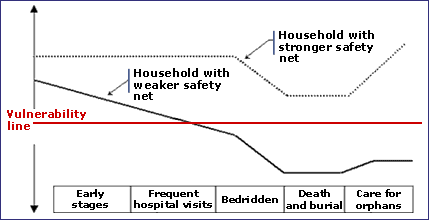- Mr Dan Mullins, Oxfam-GB
Mr Mullins set the scene for the seminar with an overview of the current
and potential impact of HIV/AIDS on land reform and agriculture, categorizing
the impact into three areas: people / households, use of resources and
institutions. He indicated that an important starting point is to look
at the phases through which people progress when they have HIV/AIDS:
asymptomatic; early illness; chronic illness; critical illness; death
and lastly, survivors.
Each phase of the disease is associated with a different impact.
It is important to note that there is another category on this continuum
beyond death of the infected person, that is, the category of survivors.
HIV/AIDS has a massive impact on those left living – there are many more
affected than infected people. Mr Mullins referred delegates to the
diagram below, which shows the value of use of micro credit at various
stages of illness to reduce vulnerability of households. That is,
households with a stronger economic safety net and a wider range of
options (including land) to draw upon during the crisis are less
vulnerable at each stage of the continuum of HIV/AIDS illness than their
poorer counterparts. Policy makers and planners need to note this as
it affects the relevance of their interventions in any community.
The effect of HIV/AIDS on households/livelihood
strategies

The dotted line represents the rate of degradation experienced by a
household with a stronger economic safety net and a wider range of
options (including land) to draw upon during the crisis. The other
line represents the rate of economic degradation experienced by a
household with a weaker safety net. The different rates of degradation
appear to pivot on the presence or absence of physical assets, business
income and access to credit or savings.
Turning next to the impact HIV/AIDS has on people and households, he
indicated that there is a general pattern as people move along the
continuum of HIV/AIDS illness. We know from statistics that HIV/AIDS
is affects the most economically productive members of the population.
At a household level the impact of this are significant with labour,
skills and experience, income and expenditure of the household all being
affected. Briefly, as illness progresses so the ability of the infected
person to earn an income is reduced, the household looses its primary
source of income, placing a strain on household income and resources.
Loss of skills and experience is also a growing problem as the most
productive members of the household die before they are able to pass on
their experience and specialist skills to the next generation.
This reduces the ability of other members of the household to recover from
expenses incurred. Further pressure is also placed on the household budget
as cash is used to pay for medication, and time of family members is
diverted away from other activities (like farming) to caring for the sick.
Households' ability to cope will also depend on the extent to which they
can adapt to the changes in household composition (age, gender) brought
about by HIV/AIDS, and their ability to take on new roles and
responsibilities. Policy makers and planners need to note these changing
relationships in households as they will affect both with whom they
engage and how they plan interventions.
HIV/AIDS also impacts on the use of resources. Ill health, and time
spend in caring for sick, reduces time spent in farming, leading to under
utilization of resources and reduced productivity. In some cases this has
resulted in changing use of land as households move away from more to less
labour intensive, and often less nutritious, type of crops. In some cases
land has even been left fallow or abandoned. Other households have been
tempted to rent out or sell their land in order to raise extra income to
meet additional household expenses due to HIV/AIDS. Selling off
productive resources like land and farming implements has critical
long-term implications for the household, increasing their vulnerability
and sustainability in the long term. Forced removal of widows from land
and property grabbing has also become issues that need urgent attention
from policy makers and land officials.
Mr Mullins also looked at the impact of HIV/AIDS on institutions such as health, welfare and the Department of Land Affairs and Agriculture. HIV/AIDS has implications for their sustainability, effectiveness and ability to cope with increased demands. He noted that HIV/AIDS would increasingly impact on and change the environment of institutions. People and cliental, as well as ways of working with people, will change; and there is likely to be a significant effect on morale. The internal capacity of organisations will also be affected as more staff become infected and affected. Most notably, as infection rates increase, so too will absenteeism and staff productivity decrease. This will be coupled with increasing financial costs to the institution in retraining staff to replace those who fall ill and die, severance and hiring, loss of time, drain on medical aid funds, increased death benefits and pension payouts. Staff turnover will also increase as staff get sick and need to be replaced, and competition for skilled staff will increase as the pool of skilled and experienced individuals is reduced.
He said the result of the above scenario is that we need to assess and reassess regularly the quality and relevance of the current services our institutions provide. We may find that we need to be addressing things differently. We should also be asking what we should be doing to safeguard our business and ourselves so that we are sustainable in the future.
|






